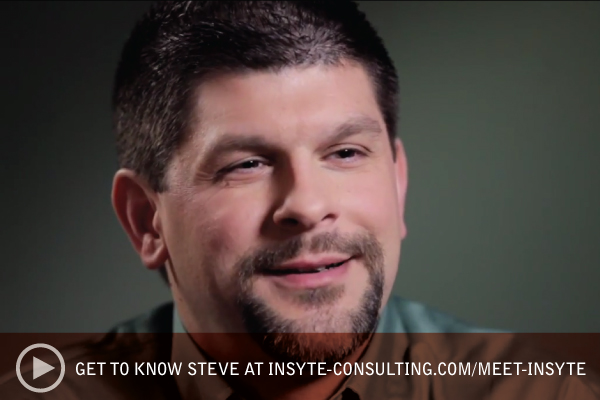In this issue of Insights, we talk with consultant Steve DiIoia about his role on the Insyte team. Steve brings to Insyte a distinction that not many consultants in the industry can claim: he is a certified Master Black Belt, trained in the Six Sigma methodology of efficiency analysis and problem solving, and a certified management coach. Here, Steve discusses his role as educator as both a Six Sigma mentor and management coach.
What is a Master Back Belt in Six Sigma?
The Master Black Belt is the highest level for Six Sigma. It’s a problem-solving method that utilizes the following steps: DMAIC—define, measure, analyze, improve, control. There are different levels. There’s White Belt, for executive training, which deals with methodology, how you implement and manage from within the organization; Yellow Belt, which is general training for the employees, so they have an understanding of what Six Sigma is; Green Belt, which implements a lot of the work (I received my Green Belt training at Motorola, which invented Six Sigma); Black Belt, which trains you to be one of the main implementers within the organization; and Master Black Belt, which involves higher skill and leadership training, and also mentors and trains other Black Belts. A Master Black Belt sort of oversees the whole Six Sigma program.
Why do you think Six Sigma is so successful?
I think it’s successful because of the fact that the methodology just makes sense, and should be used whenever you’re problem solving. A true Six Sigma project is going to take at least six months, on average. But you can still use the Six Sigma methodology, even if you’re doing a quick problem solve. Defining the problem is very important. If you don’t define it, you might not be solving the right problem. There’s a term in manufacturing known as “firefighting,” which is when you basically slap a Band-Aid on a problem and move on, whereas with Six Sigma, you really solve the problem.
Has teaching always been an interest?
I’d like to think I’m pretty good at it. Especially when some of the material can be pretty dry, because it’s statistics and not a lot of people get excited about that. It’s not just teaching, but also the mentoring. To see people grow and improve their skills, improve their situation, helping them out—that’s where there’s really a joy of it, the excitement of it.
What does it mean to be a management coach?
As an executive coach, or performance coach, I can do a variety of things, it just depends on what the client is facing. As a consultant, a client wants an answer, and you give them an answer. A mentor is one step above that, where you’re kind of showing them the answer but also guiding them, showing them how it’s done so they can do it themselves. Then there’s a coach, who really isn’t there to give an answer, but to guide the person to find his or her own answer. The next step would be counselor, who deals with the past, to figure out why it’s affecting the future. As a coach, we really don’t care about the history or the past; we’re focusing on the present, and what’s got you stuck. How can we work together as a team to move you forward?
What do you like about coaching?
For me, it’s the reward of seeing that person relieve their pressure, their tension, because they’re stuck. That moment when that awareness is raised, and they have that “a-ha” moment. When I can see that person in a much better state, and see that worry dissipate. When they’re in a much better place. That is great to see.
What problem is most prevalent among those who seek coaching?
The fact that we may know our weaknesses—and we may not—but when people think they can either overcome their weaknesses, or hide their weaknesses, or compensate in some way, that’s a problem. Especially leaders, who I think feel they can’t be weak in any area. If you’re weak in an area, the people that you’re leading know it. It’s not a secret. A lot of leaders like to think it is, but again, when I coach, I’m there to raise awareness of that weakness and help them deal with it. It’s a relational issue with a staff, whether it’s how to deal with people on the staff, or how to come off not trying to be the perfect leader, because you think you have to be perfect in everything.

